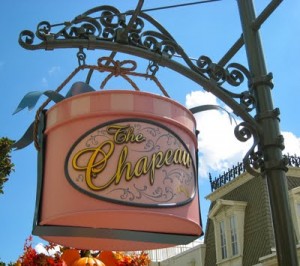Tony’s Town Square And The Hatbox
There is a great story about the relationship between Walt Disney and his older brother Roy in Bob Thomas’s excellent book Building A Company: Roy O. Disney and the Creation of an Entertainment Empire. Roy was talking about Walt when he was only five years old. Walt found a knife and Roy took it away saying, “Look, you can’t trust yourself with a knife, you’ll cut yourself.” Many years later, the brothers were having a fight and Walt accused Roy of bullying him and reminded his brother that “You’ve been doin’ that since I was born. I remember you took that knife away from me in Fort Madison.” Roy could only state, “That was sixty years later. Talk about an Elephant!”
 Another example of Walt’s memory creating special moments is right up front in Town Square at the Magic Kingdom. I noticed this subtle link during a recent trip to Tony’s Town Square. I sat down to enjoy my meal in the atrium area up front (one of the best reasons to eat there). It was a pleasant day and I enjoy the openness and air-conditioning of the dining room and the great service. Debate amongst yourselves the value or the quality of the food. Go ahead.
Another example of Walt’s memory creating special moments is right up front in Town Square at the Magic Kingdom. I noticed this subtle link during a recent trip to Tony’s Town Square. I sat down to enjoy my meal in the atrium area up front (one of the best reasons to eat there). It was a pleasant day and I enjoy the openness and air-conditioning of the dining room and the great service. Debate amongst yourselves the value or the quality of the food. Go ahead.
We all know that Tony’s Town Square is themed to Lady and the Tramp. Could it be the paw prints out front, the music box, the huge statue in the main dining room or the stained glass windows? It was while I was staring at these windows while waiting for my salad I made a discovery that would forever change my life.
 Looking through the window I noticed that the representational sign for the Chapeau Shop is a hatbox. Not just any hatbox but one with a long, long Disney history. Back when Walt and Lillian first got married, he decided he wanted to give his bride a dog for Christmas. So he found a little Chow puppy and bundled her into a hatbox. When Lillian unwrapped the package out popped this dog. According to her daughter Diane, Lillian loved this dog.
Looking through the window I noticed that the representational sign for the Chapeau Shop is a hatbox. Not just any hatbox but one with a long, long Disney history. Back when Walt and Lillian first got married, he decided he wanted to give his bride a dog for Christmas. So he found a little Chow puppy and bundled her into a hatbox. When Lillian unwrapped the package out popped this dog. According to her daughter Diane, Lillian loved this dog.
 Many years later, Walt would use the same gag in Lady and the Tramp. The hatbox sign is the same one used in the film. I pointed this out to my server who had been working at this same facility for eight years and he had never noticed it before. The placement is intentional of course and a great tribute to a man who knew how to recycle a good idea if it helps to advance the story.
Many years later, Walt would use the same gag in Lady and the Tramp. The hatbox sign is the same one used in the film. I pointed this out to my server who had been working at this same facility for eight years and he had never noticed it before. The placement is intentional of course and a great tribute to a man who knew how to recycle a good idea if it helps to advance the story.
I hope you get a chance to check out my new book Walt and the Promise of Progress City. This is what Len Testa had to say:
“This book is the first to explain – in basic architecture terms – how Disney’s theme parks were designed. It is a fascinating read for anyone who enjoys spending time in Disneyland or Walt Disney World and wants a deeper understanding of why the parks were constructed as they are. While there are other good books on Disney architecture, they tend to describe the parks’ architecture along the lines of “The Imagineers chose A and B to represent the American west” without explaining why A and B were chosen. In contrast, Sam’s book explains why these choices were made, and from where either Walt or the Disney Imagineers probably saw these architecture patterns in use before.”




